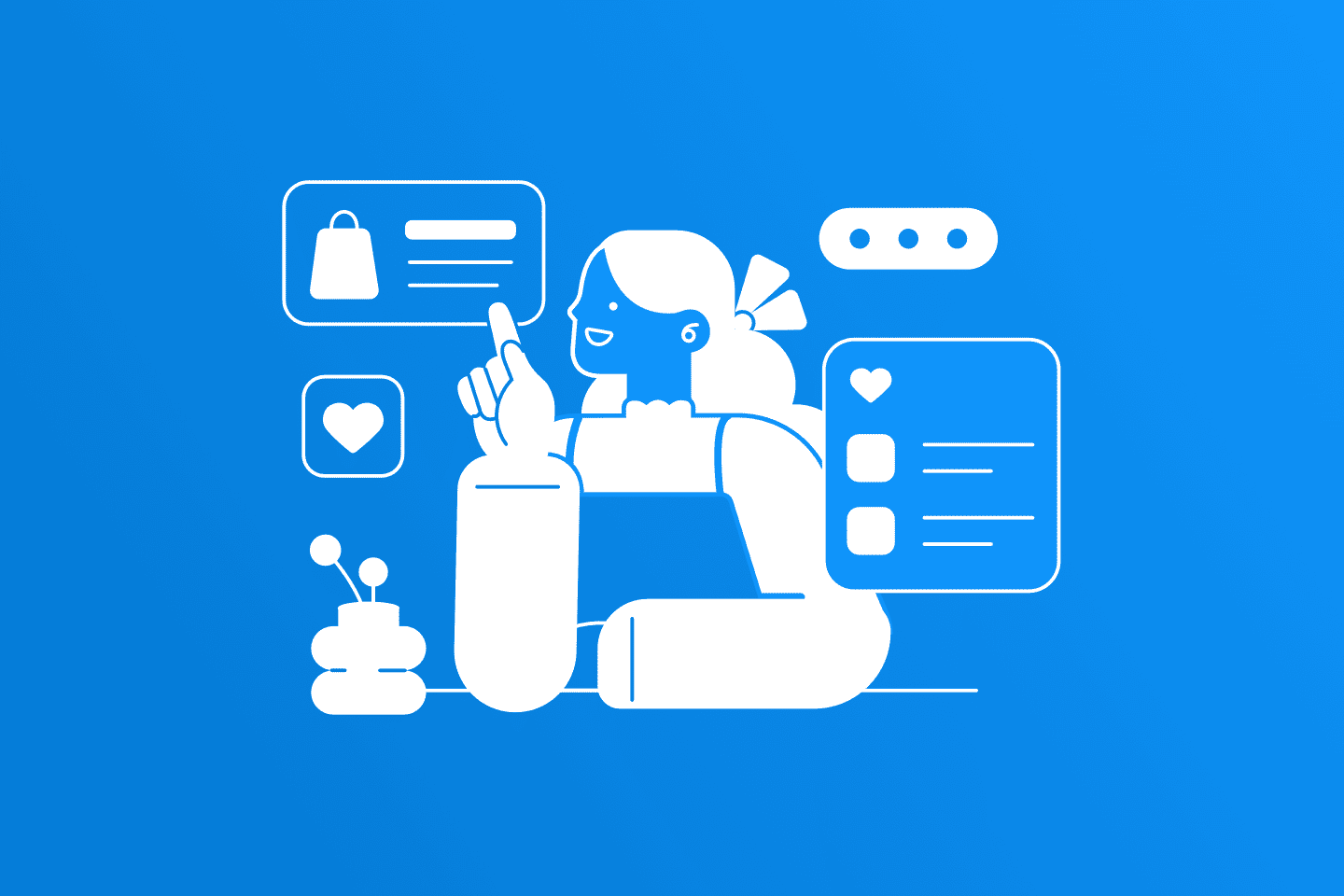Customer loyalty is the driving fuel that leads businesses to longevity and success.
Stats show us that the probability of selling to an existing customer is a whopping 60-70% while around 80% of your profits come from just 20% of your customers.
This reveals one thing. The best product any business can have is a loyal customer, and the most profitable marketing channel they can have is word-of-mouth marketing.

What is Customer Loyalty
Customer loyalty is the feeling a customer has about a brand that makes him use their product or service repeatedly.
What sparks that feeling in the customer can be very different. It can be product quality, service, brand values, or other things. As the matter of fact, 56% of the customers said that they stay loyal to brands just because they “get them”.
But customer loyalty doesn’t just suddenly happen to your customers. It’s the result of multiple positive experiences that occurred to the customers. Those experiences subconsciously lead to developing a feeling about your brand when they see it.
Why It Is Important
In the sea of brands and products out there today, the customers will choose the one that they have positive feelings about.
Having loyal and happy customers leads to customer retention. Just a slight 5% rise in customer retention can lead to a more than +25% rise in profit.
It’s important to build relationships with customers by giving them the best-personalized experience that you can. Because having a big number of regular customers that are loyal to your brand will be the main source of your company’s income in the future.
How To Create Loyal Customers
1. Great Customer Service
Nothing can replace the importance of good customer service. It’s the heart of the business and the key to building meaningful relationships with customers.

Having exceptional customer service can completely transform your brand image and create loyal customers.
On the other side, if you have bad customer service, people will associate your brand with that poor level of service they experienced. And no matter how good the product is, they are not likely to become loyal to your brand.
Think of your brand as a person and the customer service as the voice of that person. You want that voice to be friendly, helpful, and more importantly, to be able to build relationships with your customers.
If you think that it’s time to step up your customer service game, we are here to help.
2. Personalized Communication
Personalized communication will let your customers know that you understand and relate to them.
Comprehend who your target customers are and adjust your brand presence accordingly so people will relate to your brand.
Social media platforms are great at showing your customers personalized content. But if you want to target them on an even more personal level, email marketing is the way to go.
Once you have their email, the one-on-one communication begins. Trust me, this is where you build lasting relationships with your customers.
You can create an email marketing strategy that will be highly personalized and offer great customer satisfaction which leads to brand-loyal customers.
According to this data, 80% of businesses rely on email marketing as the driver of customer retention. Can you afford to miss out on this powerful tool for creating customer loyalty?
3. Customer Loyalty Program
63% of high-performing marketers are already using loyalty program platforms. Think that’s by accident? Well, think again.
Customer loyalty programs are used by businesses all around us and their numbers are only increasing.
The digitalization of brands has made it a lot easier for them to create loyalty programs. Because it’s not hard to track the customers’ levels of loyalty and reward them accordingly.
In fact, most of us are already part of one, and it’s nice to be appreciated and rewarded for our loyalty to the brand.
People are more drawn and connected to brands that have customer loyalty programs. It feels like investing in something that will pay off in the long run.
So it’s a win-win. The customers get loyalty rewards and the brands get (and keep) loyal customers.
4. Ask For Honest Feedback
Asking for customer feedback is great for more reasons.
First of all, the customers will know that their voice matters and that you care to give them a positive experience when interacting with your brand.
Secondly, you can take the results from the customer experience surveys and use them to continuously improve your brand.
This feedback comes directly from your customer base, it’s very relevant, and it will show you in which direction your customers want you to take your brand.
It’s best to send the surveys through email or website and for them to be effective, you can use these directions.
- Keep it short. Of course that you want to use the opportunity to gain more information about your customers. But the bigger you make it, the fewer people will do it.
- Nail the timing. You can’t just throw surveys around and expect everyone to engage. Asking your VIP customers or just using the spirit of holidays like get to know your customers day or end of the year’s resolution usually works the best.
- A/B test it. We can only guess which copy or design will create bigger customer engagement until we test it. The results will surprise you sometimes.
- Express your gratitude. In the end, don’t forget to thank everyone for taking some of their time to answer the survey. And also for showing interest and effort to improve your (and their) brand.
5. Long-Term Strategy
Long-term strategies lead to long-lasting relationships.

Customer relationship is not something that you can build overnight, It takes time to start seeing the benefits of customer loyalty. But once you do see the results, you won’t turn back.
A solid brand strategy that focuses on customer retention is always going to work better than any other short-term answer.
Because it’s not just about creating loyal customers, it’s about keeping them. Having a long-term customer loyalty strategy will allow you to retain them longer.
Measuring Your Progress
Net Promoter Score (NPS)
NPS is the metric that measures customer loyalty by asking a simple question to the customers. How likely are you to recommend our brand to others?
It’s measured on a scale of 1-10.
In the end, you collect all the data and calculate the average score for your brand.
-If your brand is on the 0-4 scale, your customers are not happy and you have a lot of improvements to do.
-If your brand is on the 5-7 scale, your customers are kinda neutral and consider your product average. But loyal customers don’t settle for average.
-If your brand is on the 8-10 scale, you are doing a great job! But don’t stop here, there is always room to improve.
Customer Retention Rate
Customer retention rate is the % of customers that a company can retain after a certain amount of time.
We already know how important customer retention is for any business, and this metric is measuring exactly that.
But how?
First, you need the number of all customers at the end of a period.
Then, you subtract the number of new customers gained during that time.
You take that number and divide it by the number of customers that you had at the beginning of the period.
And multiply it by a hundred.
This might be one of the most valuable metrics that can show you in which direction your business going in the long run.

Customer Satisfaction Score (CSAT)
CSAT is a great indicator that shows you the number of satisfied customers from your brand.
It’s measured on a scale of 1-5 with 1 being not satisfied at all and 5 very satisfied. These surveys are usually sent after the customer uses/receives your product or service.
You calculate the % customers who are satisfied by taking the number of satisfied customers (the ones that voted 4 and 5) and dividing it by the number of total customers that participated in the survey and multiplying it by 100.
A valuable product is the most ingredient in creating loyal customers, don’t overlook it.
Customer Lifetime Value (CLV)
Customer lifetime value is the amount of money that the customer spends during the entire relationship with you.
A high customer lifetime means that you have loyal customers that stay with you longer.
This metric will show you how much profit a customer brings on average. You can use this number later on to adjust the amount of money you spend to acquire a new customer.
To Wrap Things Up
Having a strategy that focuses on loyal customers is the key to the long-term and short-term success of any business.
But creating customer retention means that you have to improve a lot of aspects of your business. From great customer support and personalized communication to a loyalty program, everything in your brand should be on-point to score a loyal customer in the highly competitive market today.
Set up your business to be of value for your customers, and track the progress that you make with metrics that are real indicators for customer loyalty in your brand.






